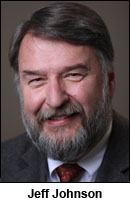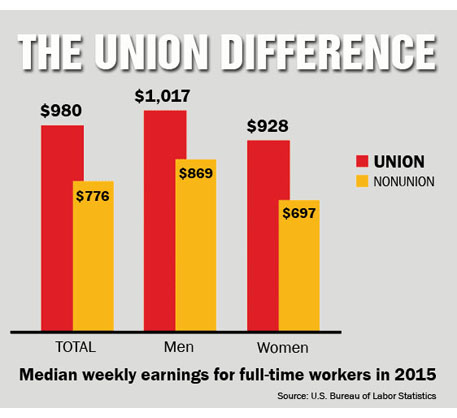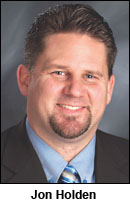NATIONAL
Union membership up in Washington state
With 9,000 more members, state is now 5th most unionized in U.S.
WASHINGTON, D.C. (Jan. 29, 2016) — A half-million Washington state residents belonged to labor unions in 2015, a new report from the U.S. Bureau of Labor Statistics shows. The ranks of union members in the state grew to 500,000, up from 491,000 in 2014.
 “I am encouraged by the increase in union membership in our state,” said Jeff Johnson, President of the Washington State Labor Council, AFL-CIO. “It reflects the fact that labor and community are organizing together against the forces of inequality to create a more broadly shared prosperity.”
“I am encouraged by the increase in union membership in our state,” said Jeff Johnson, President of the Washington State Labor Council, AFL-CIO. “It reflects the fact that labor and community are organizing together against the forces of inequality to create a more broadly shared prosperity.”
The 2-percent growth in union membership is good for the state’s economy, added Jon Holden, the president of Machinists Union District Lodge 751 and Vice President of the Washington State Labor Council, AFL-CIO.
“Union members earn more money, so when union membership increases, that means more workers have more money to spend,” Holden said. “That’s good for local businesses, good for local communities — and certainly good for those 9,000 new union workers and their families.”
 Nationwide, the average union member earned $980 a week in 2015, or nearly $51,000 a year. That was 26 percent higher than the average pay for non-union workers: $776 a week, or about $40,400 a year. That difference — $204 a week — means roughly $10,600 a year more for union workers, Holden noted.
Nationwide, the average union member earned $980 a week in 2015, or nearly $51,000 a year. That was 26 percent higher than the average pay for non-union workers: $776 a week, or about $40,400 a year. That difference — $204 a week — means roughly $10,600 a year more for union workers, Holden noted.
“An additional $10,000 a year makes it easier to buy a home or save for a child’s education,” he said. “The American Dream is more within your reach if you are a union member.”
LEARN MORE ABOUT FORMING A UNION — If you don’t have a union at your job, learn more about how to organize one. Today’s economy is so out of balance — with all the economic gains going to the top — more and more people are looking into joining unions so they can share in the prosperity their work creates. You can be one of them! Click here to get started!
Washington has the fifth-highest union density of any state, with 16.8 percent of the workforce being union members. Only New York (24.7 percent), Hawaii (20 percent), Alaska (19.6 percent) and Connecticut (17 percent) are higher.
The annual wage survey follows another federal report that showed union members are far more likely to have employer-provided retirement and health care benefits than their non-union counterparts.
In 2014, the Bureau of Labor Statistics found:
— 95 percent of union workers had the option of an employer-sponsored health care plan, compared to 69 percent of non-union workers;
— 94 percent of union workers had the option of an employer-sponsored retirement plan, compared to 65 percent of non-union workers; and
— 93 percent of union workers had the option of an employee-sponsored prescription drug insurance, compared to 67 percent of non-union workers.
In addition, the quality of the benefits provided to union workers typically was better, the data showed. For example, workers were expected to contribute 19 percent toward the cost of the family’s health care under union-negotiated benefits plans, while non-union workers were forced to shell out 35 percent of the cost, which represents an 84 percent increase in out-of-pocket costs.
 “We often say it pays to be union,” Holden said. “But there are clear benefits to being in a union as well.”
“We often say it pays to be union,” Holden said. “But there are clear benefits to being in a union as well.”
Nationwide, there were 14.8 million Americans who belonged to unions in 2015, representing 11.1 percent of the total workforce.
The Machinists Union District Lodge 751 contributed to this report.





